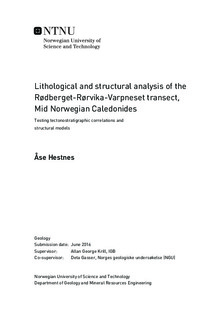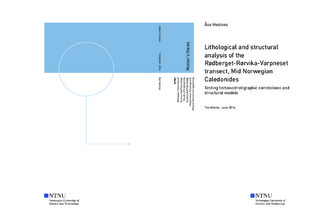| dc.description.abstract | Remnants of the Caledonian orogen are visible through tectonostratigraphic and structural fingerprints in Central Norway, and the detailed study of key localities is important for the understanding of the overall evolution of this orogeny. In this study, a lithological and structural analysis of the Rødberget-Rørvika-Varpneset transect on Fosen peninsula, South-Trøndelag, is conducted. In earlier studies, several tectonostratigraphic hypotheses were proposed for this area: 1) the central amphibolites belong to the Støren Nappe, whereas the surrounding mica schists belong to the Gula Nappe, 2) Seve Nappe Complex, Gula and Støren nappes are represented in the area, and 3) the entire area can be correlated to the Seve Nappe Complex. In addition, it was proposed that the central amphibolites represent a larger synformal structure. With the help of lithological mapping, geochemical analysis of aplites and amphibolites, and U-Pb zircon dating, these earlier proposed tectonostratigraphic correlations and structural models are tested in this study. The study area is divided into four units: the Rødberget, Trongen, Rørvika and Varpneset units. The Rødberget unit represents Baltoscandian basement, whereas the Trongen, Rørvika and Varpneset units are correlated with the Seve Nappe Complex based on the following lines of evidence: 1) lithological similarities to Seve Nappe Complex rocks in Central Norway and Sweden, 2) penetrative at least amphibolite-facies metamorphism, 3) U-Pb zircon dating of an intermediate layer within the central amphibolites yielding an age of 435.4±3.3 Ma, interpreted to be the result of decompressional melting of amphibolites related to exhumation of the Seve Nappe Complex, and 4) the presence and geochemistry of aplites, which have intruded both mica schists and amphibolites, resembling similar intrusive rocks in the Seve Nappe Complex, which were emplaced at about 430 Ma. In addition, through a detailed structural analysis of foliations, lineations, fold axes and fold vergences it can be shown that the central Rørvika unit is not lying within a synform, but rather represents a wedge-shape structure where the vergence of the smaller folds reflects the movement of the lithologies in the area. Two large-scale models are proposed for the ductile structural evolution of the entire area: 1) an obstacle and buckling model, and 2) a rotation model. Both models are related to the evolution of antiformal basement windows and the Møre-Trøndelag Fault Complex (MTFC). Stress inversion of brittle structures shows that the study area has been affected by a NW-SE extensional event, reactivating the MTFC in Late Paleozoic to Late Mesozoic/Early Cenozoic. These results imply that the area of interest has experienced a different structural evolution than earlier proposed, with a different and more complex metamorphic and structural history. This has implications for tectonostratigraphic correlations across Trondheimsfjorden. | |

